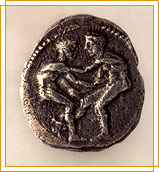Athletics and representations in art
Undoubtedly most of the representations of athletes, sports and scenes at the Palaestra and the Gymnasium appear on works of pottery.  The relevant themes, mainly chariot races and running events, appear already from the 2nd millenium BC on Mycenean vessels. Such representations continued occasionally during the Geometric period, while their heyday was during the 6th and the 5th century BC with the Attic black-figured and red-figured vases. The best known vessels with athletic representations were the Panathenaic amphorae, which, filled with oil, were given as prizes in competitions in honor of the goddess Athena in Athens. Such vessels have been found all over the Mediterranean and depict on the one side the event in which the athlete was victorious and on the other the goddess Athena. Athletic subjects have also been depicted from an early time on the vessels of Southern Italy, mainly in cylindrical aryballoi, which contained the oil with which the athletes anointed themselves. The relevant themes, mainly chariot races and running events, appear already from the 2nd millenium BC on Mycenean vessels. Such representations continued occasionally during the Geometric period, while their heyday was during the 6th and the 5th century BC with the Attic black-figured and red-figured vases. The best known vessels with athletic representations were the Panathenaic amphorae, which, filled with oil, were given as prizes in competitions in honor of the goddess Athena in Athens. Such vessels have been found all over the Mediterranean and depict on the one side the event in which the athlete was victorious and on the other the goddess Athena. Athletic subjects have also been depicted from an early time on the vessels of Southern Italy, mainly in cylindrical aryballoi, which contained the oil with which the athletes anointed themselves.
In ancient painting, athletic themes were already depicted on Minoan wall paintings at the Knossos palace, where a representation of a youth attempting to jump over a bull and the well-known scene with the prince-boxer have been preserved.  Nevertheless, Philostratus' description of a library of the Roman years demonstrates the interest of painters of later years in such themes. In the Roman period we have also extensive representations of games in mosaics, inspired from Greek art, which are related to the particular heyday of the Games during the Imperial period. Such types of mosaics in Ostia, Rome, Sicily and North Africa preserve numerous details of ancient athletic practices. Nevertheless, Philostratus' description of a library of the Roman years demonstrates the interest of painters of later years in such themes. In the Roman period we have also extensive representations of games in mosaics, inspired from Greek art, which are related to the particular heyday of the Games during the Imperial period. Such types of mosaics in Ostia, Rome, Sicily and North Africa preserve numerous details of ancient athletic practices.
Regarding the reliefs, besides the stone pedestals of statues of athletes, there are also funerary or votive stelai (columns) that have been preserved, as well as Roman sarcophagi with representations of athletes in characteristic activities. Among the reliefs that decorated the pedestals of statues of athletes the most important ones are those that have been found in the Themistoclean wall of Athens and are dated to the Archaic period. Representations of the dead as a boxer, an athlete with a strigil, a wrestler, a javelin thrower, a discus thrower or a jumper can be seen on funerary reliefs.
Furthermore, numerous athletic themes were depicted on coins. Hieron, the tyrant of Suracuse, and Anaxilas, the tyrant of Rhegium, minted gold coins commemorating their important victories in chariot races. Philip II of Macedonia also struck coins to commemorate an equestrian victory in Olympia. In addition, coins with representations of specific contests have been preserved. The figure of an hoplite-runner decorated one side of the coins of Cyzicus, a city in north Asia Minor. For two centuries, until the middle of the 5th century BC, the island of Kos minted coins with the representation of a discus thrower next to a tripod. Two wrestlers in a variety of positions are also encountered on the coins of Aspendus, a city in south Asia Minor.
|
